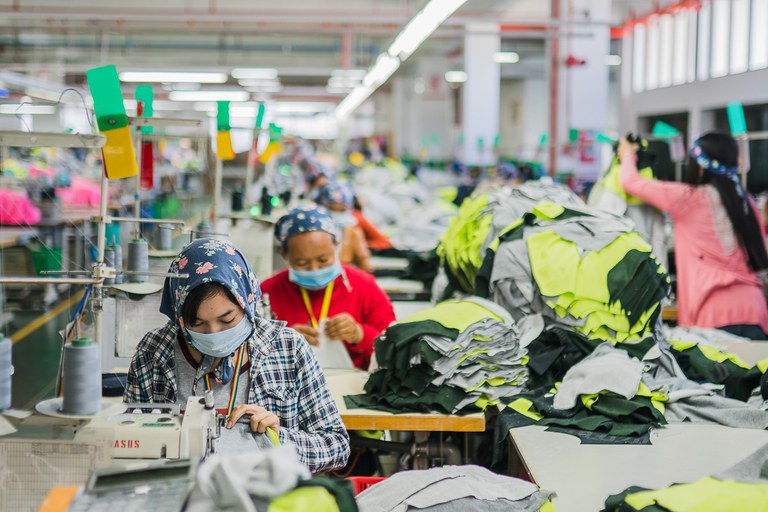Voices of the industry: “This widespread breakdown across the industry has illuminated how fragile the system really was”
Industry experts agree that the COVID-19 pandemic will continue to shape garment production in Asia far into 2021 and beyond. But how will the pandemic affect garment production systems and practices? And how will this impact manufacturers and workers? Here are the perspectives of industry stakeholders.
Impact on production systems and practices: “Suppliers must invest in data systems”
“In a crisis, we all tend to retreat to the known. If you retreat back to your own home country, you don’t have to deal with foreign currency fluctuations, political uncertainties or the complexities of travel in the age of the pandemic. But the reality is that we are a lot more globalized and a lot more interdependent than we think we are. So the quality of life that we enjoy is only possible with globalized supply chains.”
Edwin Keh, CEO, Hong Kong Research Institute of Textiles and Apparel
“I believe the production system will be more flexible in the future and more reliable on things like manufacturing excellence, industrial 4.0, virtual sampling, virtual auditing and virtual inspection. This will impact the layout of the production and also the resources, for example, how we will allocate our workers resources in the factories.”
Catherine Chiu, General Manager, Corporate Quality & Sustainability, Crystal group
“You will have artificial intelligence that will help to determine what materials are available and where they are located in the supply chain. So what you can promise is based much more on solid figures about what is available at the Tier 3 yarn level or the Tier 2 fabric level. That enables you to say “Yes, I have everything I need or I can get everything I need in a week - so I can take that order and deliver those 10,000 pieces you want”. In the past, it was very hard to get that information. The data revolution is changing that, but it also requires more sophistication. So what that means is that suppliers must invest in data systems and people that understand them, and that will not be cheap.”
Duncan Scott, Senior Vice President Strategic Sourcing & Quality, New Balance
“It’s not that these issues haven’t been raised and discussed in the past, or that you haven’t had organizations working on them for a very long time. But the situation has never been so extreme and these dynamics have not had such a massive impact all at once. Due to the effects of the current crisis, people are placing greater emphasis and scrutiny on how things have been set up and the implications. This widespread breakdown across the industry has illuminated how fragile the system really was.”
Amina Razvi, Executive Director, Sustainable Apparel Coalition (SAC)
Impact on factories: “We don’t work with buyers that only offer a win-lose situation”
“We will see a consolidation of the supplier base going forward and much stronger partnerships. We saw this trend coming before. The fashion industry needs to become more agile. Therefore, we need to discuss with our suppliers how we work together to cater to our common customer. We need to keep them involved in our processes and we also need to understand each other’s business models to come up with win-win propositions.”
Payal Jain, Social Sustainability Manager, H&M
“The reason why PT Pan Brothers can make it and others might not is because we don’t work with buyers that only offer a win-lose situation. So we have actually stopped working with some buyers who only consider things from their own perspective.”
Anne Sutanto, Vice-CEO, PT Pan Brothers
“The way to get things faster and cheaper is to work together... [You] have got to really have a strong partnership with suppliers to be able to deliver and to do so quickly.”
Marsha Dickson, President and Co-Founder, Better Buying
Impact on workers: “Workers are obviously at the bottom end of that supply chain power dynamic”
“Our members are also facing difficulties because of this pandemic. Buyers are cancelling orders, which has forced suppliers to ask workers to stay at home or to lay off workers without any salary.”
Elly Rosita Silaban, President, All Indonesian Trade Union Confederation (KSBSI)
“Anytime a crisis like this happens, you have to assume that people who have the power will push as much of the risk down the supply chain as they can. Workers are obviously at the bottom end of that supply chain power dynamic. So they’re going to suffer as a result.”
Ian Spaulding, CEO, Elevate
“To the extent that there will be fewer buyers because of this consolidation, and to the extent that we see increased push towards coordination among the buyers, then the bargaining power of those buyers will actually increase even more. That might actually result in better working conditions because they can pressure the factories to improve.”
Raymond Robertson, Director of the Mosbacher Institute for Trade, Economics, and Public Policy, Texas A&M University
“As jobs in garments and other sectors become more scarce, the remaining jobs may become more attractive. We might see women start to get more and more crowded out of regaining access to jobs because once those jobs become more attractive, men tend to go for them and generally they have a better chance of getting employed.”
Joe Sutcliffe, Senior Dignified Work Advisor, CARE
How will Covid-19 shape the textile industry?
The voices from the industry indicate that the COVID-19 pandemic will continue to shape garment production in Asia into 2021 and beyond. And they reveal, above all, that the complex structure and the multitude of players involved at different points in the supply chain make it difficult to predict a single fate or future for the industry as a whole. It is therefore more likely that the sector will develop in many different, sometimes competing and contradictory ways in the coming years.
But what impact will COVID-19 have on production systems and practices? What role will technology play? How will the relationship between buyers and suppliers evolve? What does this imply for factory workers? And how will factories compensate their financial losses?
If you want answers to these key questions and learn more about how the textile sector might change after COVID-19 and whether experts believe Asia will continue to dominate global textile and garment production, then download the report "What next for Asia's garment production after COVID-19 - The perspectives of industry stakeholders" here.

